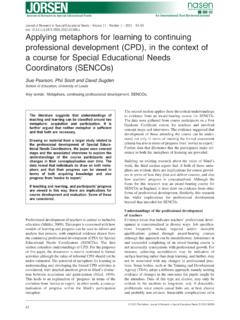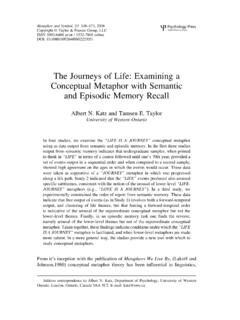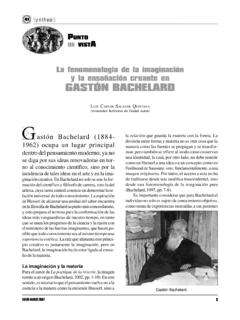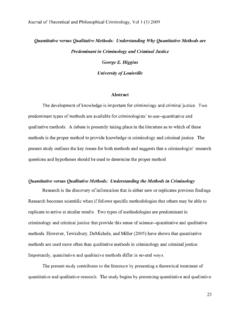Transcription of NOT ANOTHER MEDICAL MODEL: USING …
1 NOT ANOTHER MEDICAL MODEL: USING metaphor AND ANALOGY TO EXPLORE CRIME AND CRIMINALJUSTICE1 Rob Canton, Professor of Community and criminal justice , De Montfort University,LeicesterAbstractThis paper considers the place of metaphor and analogy in criminal justice (and speaking) metaphorically is an unavoidable aspect of the framing of socialproblems. Some examples are offered of the ways in which these figures of speech andthought may influence how we think about these matters, variously generating new ideas orperhaps constraining other possibilities.
2 Metaphors may also be emotionally evocative,influencing feelings as well as thoughts. It is argued that the (often concealed andembedded) assumptions that metaphors import or sustain need to be exposed andsometimes challenged, if liberal criminology is to make its due contribution in debate aboutcriminal justice policy. We need new ways of thinking and talking about the relationshipbetween crime and criminal justice . In the second part of the paper, a specific analogy isdrawn - between, on the one hand, crime and criminal justice and, on the other hand,health and medicine.
3 Several points of correspondence are identified and some ideas that areperhaps more familiar in the sociology of medicine are used to illuminate criminal analogy exposes some of the assumptions in criminal justice debate and offers anotherway of thinking and talking about policy. IntroductionThe first part of this paper considers the use of metaphor and analogy in criminal justicediscourse. When the attempt is made to understand complex phenomena like crime andcriminal justice , metaphor and analogy are usually deployed.
4 Invoking a metaphor proposes,or more often implies, that crime and criminal justice are like this. It will be argued thatthese figures of speech (but also figures of thinking) exercise a powerful and tacit influenceon the way in which people talk and think about criminal justice an influence all the morepowerful because tacit. Becoming aware of the metaphors and their influence may be aprecondition of finding other ways of engaging effectively in the policy the analysis focuses on the politics of criminal justice in England and Wales, it seemslikely that it has relevance for other countries besides.
5 Many countries, for example, areexperiencing a new punitiveness (for example, Pratt et al., 2005; although for a differentview, Matthews, 2005) and it will be argued that the language of debate and the metaphorswith which it is infused should be understood as one important aspect of the way in whichpenal trends emerge and are sustained. The second part of the paper draws a particular analogy - between, on the one hand, crimeand criminal justice and, on the other hand, health and medicine. Having set out the basisof this analogy, the paper identifies other points of correspondence.
6 The analogy, then,offers ANOTHER way of talking and thinking about criminal justice . metaphor and Analogy in criminal JusticeThibodeau, McClelland and Boroditsky assert that Our language for discussing war, crime,politics, healthcare, and the economy is suffused with metaphor (2009: 809). metaphor isalready pervasive and one of the ways in which we try to make sense of the world (id. andreferences there cited) and perhaps the more abstract and complex a problem, the greaterour need to liken it to a more familiar phenomenon.
7 We need metaphors to explore whatkind of thing crime is and, if this is our aim, what kind of criminal justice response wouldbe likely to reduce Sch n insists that it is "not that we ought to think metaphorically about socialpolicy problems, but that we do already think about them in terms of certain pervasive, tacitgenerative metaphors (Sch n, 1993: 139 - emphasis in original). These metaphors structureour perceptions, our understanding, our framing of problems and proposed solutions indeed what would count as a solution (Sch n, 1993).
8 In that case it must be important tobecome reflexively aware of the way in which particular metaphors and analogies function inpolitical debates, the ways in which they lead us to think and alternative interpretations thatthese figures may constrain. Sch n offers an example. He writes:One of the most pervasive stories about social diagnoses the problem as fragmentation and prescribes coordination as the Fragmented servicesbecome problematic when they are seen as the shattering of a prior integration.
9 Theservices are seen as something like a vase that was once whole and now is the spell of metaphor , it appears obvious that fragmentation is bad andcoordination, good. But this sense of obviousness depends very much on the metaphorremaining tacit (1993: 138).While Sch n was not here discussing criminal justice policy, the idea of dysfunctionalseparateness is frequently invoked in this context too. In referring to prison and probationas silos (grain? missiles?), Carter (2003) trades on a similar metaphor , one that evokes the41 Not ANOTHER American model : USING metaphor and Analogy to Explore Crime and criminal Justice42idea of pathological isolation to make a case for combining services.
10 The aspiration to joinup services may be associated with the emergence of new managerialism in the late 1970s /early 1980s, but has been common in criminal justice discourse for many years (for example,Home Office, 2000; Home Office, 2002; Casey, 2008). It is to be noted that silo is alwaysused negatively in discussions of this type: it does not simply describe a separation butdeplores it. And in this sense it performs a similar persuasive function to Sch n s example offragmentation. Now historically, of course, there never was a prior integration : the agencies of criminaljustice were never created to work together as any kind of system.












